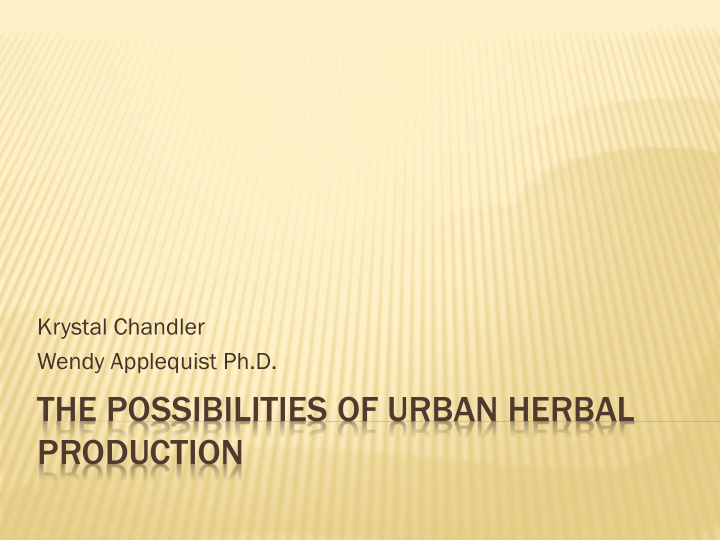



Krystal Chandler Wendy Applequist Ph.D. THE POSSIBILITIES OF URBAN HERBAL PRODUCTION
HERBAL PRODUCTION Herbal supplement sales increased 3.3% in 2010 for sales of $1.7 billion Material in most end user products originate in another country U.S. consumers believe 77% of material come from U.S. Only 12% actually originates in the U.S.
LOCALIZATION OF MATERIAL Fresh plant material Consistent quality Tropicos,org Repopulation of wild species Local economic stimulation
GOALS Identify top herbal supplements currently used in the United States Create a model for Urban Herbal Production for the City of St. Louis • Identify local consumption for select species • Assess land space needed to cultivate select species • Provide enough material to supply local market demand • Identify areas within city limits for growing space
INFORMATION REVIEW Top he p herbal l supp pplem emen ents ts Trade de statis istics tics from om obtai aine ned d from om United Uni ed Nat atio ions ns Her erbalg lgram ram 2010 0 COMTRADE RADE da database Mark rket et Rep epot Vac acan ant t lan and d ar area ea Harves est t in informa rmati tion on informa in rmati tion on from m St. from om Amer erica ican Her erbal l Louis is Land R d Reu eutil iliz izati tion on Produc Pr ducts ts Associa ociati tion on Aut uthority hority Tonnage ge Revie iew
RESULTS Tabl ble e 1: Estimated ated Total al U.S. Populati lation on Consumption tion of selec ected ted botan anicals icals and proje jecte cted land space ce needed ed to to cultivate tivate Total al cons nsumed umed Selec ected ted Botani nical al lbs/capi apita ta STL Demand and (lbs bs) Expec ected ted lbs/Acre Acres es (lbs) Echin inac acea 553,639 2.4 x 10 -3 594 2600 0.23 Echinacea purpurea Black k Cohosh osh 324557 1.4 x 10 -3 348 4000 0.09 Actea racemosa Pepper ermin int 1,160,000 5 x 10 -3 1245 2000 0.62 Mentha piperita Ginseng eng (Amer. er.) Panax quinquefolius 64,765 2.8 x 10 -4 70 2000 0.03 Hypericum St. John' n's Wort rt 621,720 2.7 x 10 -3 667 646 1.03 perforatum Matricaria Cham amomile omile 86,412 3.7 x 10 -4 93 400 0.23 chamomilla Vale leri rian an Root Valeriana officinalis 185,260 8 x 10 -4 199 514 0.39 Milk k Thistle tle Silybum marianum 170,973 7.4 x 10 -4 184 2000 0.09 Tanacetum Feverfew erfew 4,694 2 x 10 -5 5 1619 0.003 parthenium Sambucus Elderber erberry 134,235 5.8 x 10 -4 144 3500 0.04 canadensis 2.75
RESULTS All vacant lots in ward 15 More than half in ward 17 Table le 2: Summar ary y of f Possib ible e Vacan ant Land nd Space Total al Land nd Ward # of Lots (sq. ft.) t.) 15 10 40,541 17 27 79763 (Garrison, 2010)
CONCLUSION Selected botanicals can be cultivated on about 3 acres of land 37 vacant city lots Selected plants can be used to treat Colds and Flu Stomach Illness Migraine Depression and Anxiety Liver Problems Insomnia Menopausal Symptoms Crop Success depends on agronomic skill, pest/disease, weather, and soil composition Consumer demand could potentially increase cultivation area
ACKNOWLEDGEMENTS Mentor – Wendy Applequist Ph.D. REU Coordinator – David Bogler Ph.D REU Coordinator – Sandra Arango-Caro Ph.D. Missouri Botanical Garden National Science Foundation Research Experiences for Undergraduates Thank You for Listening
Recommend
More recommend